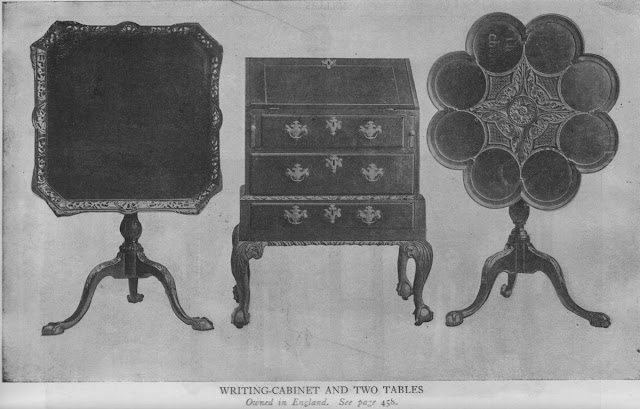The only facts reported about him are that he was born in Worcestershire, went to London and found employment as a joiner. There, in the reign of George I., he was a successful carver and cabinet maker. Some critics hold that he was already at work in 1720. If he was eminent in his craft during the reign of George I. (ie before 1727), he can scarcely have been very active later than 1765, or more than forty years afterward. It is not therefore unreasonable to suppose that he was born about 1695 and died about 1765, thus reaching a man's natural term of life.
During the second half of the century, there wer certainly two Chippendales, and probably, several of the family at work. In 1826, George Smith, who was upholsterer to the king, issued his Cabinet Maker's Guide. In this he speaks of "the elder Mr. Chippendale" and adds: "Mr. Thomas Chippendale (lately deceased) and known only amongst a few, possessed a very great degree of taste with great ability as a draughtsman and designer." Thus we have specific evidence that there were at least two Chippendales, and that one, comparatively obscure, died shortly before 1826. The latter, although a able draughtsman and designer, is very unlikely to be the same individual that had published, seventy years before, a book that was plainly the work of a man already well established in business. The more reasonable conclusion is that at least two Chippendale were engaged in designing as well as making furniture.
The lack of detailed information about Chippendale would argue that public interest in him was not very keen, and that the impression produced by his work on his contemporaries and immediate successors was not profound. If his renown had been great, we should expect to find other workmen recommending themselves at home, and more especially on going to the colonies, as having been with him, and as being able to make his well know furniture, so greatly in demand. We should also anticipate finding that furniture that was distinct in type from all that had gone before would bear the name of the famous designer, and that others would recognize his authrority unquestioningly, and confessedly follow him.
When we search for evidence on these points, we reach very curious results. Sheraton (1791) says in his preface: "I have seen one (book of design) which seems to have been published before Chippendale's I infer this from the antique appearance of the furniture, for there is no date to it; bu the title informs us that it was composed by a society of cabinet makers in London."
"Chippendale's book seems to be next in order to this, but the former is without comparison to it, either as to size or real merit. Chippendale's book has, it is true, given us the proportions of the Five Orders, and lines for two or three cases, which is all it pretends to relative to rules for drawing; and, as for the designs, themselves, they are now wholly antiquated and laid aside, though possessed of great merit, according to the times in which they were executed..."
Continued in Part Two.





No comments:
Post a Comment